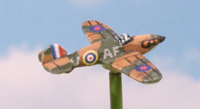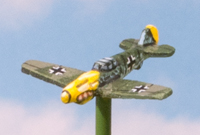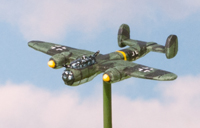Aircraft of The Battle of Britain 1940
![]()
RAF
Vickers-Supermarine Spitfire
Without doubt the most iconic aircraft of the Battle of Britain, if not the entire war. The Spitfire was designed as a high performance interceptor, tailor-made for stopping enemy raids on Britain.
In the early 1930s Reginald Mitchell had proposed a monoplane fighter based on Supermarine's experience in wining the Schneider Trophy for seaplanes. Designed to a somewhat unadventurous Air Ministry specification, Mitchell considered it too conservative and it lost out to the equally orthodox Gloster Gladiator.
As a private venture, like its Rolls Royce Merlin engine, he drew up plans for a far more advanced, virtually all-metal monoplane fighter. The prototype Spitfire first flew in early 1936. The Air Ministry, this time impressed as by now Nazi Germany was embarking on a massive rearmament, ordered 310 Spitfires a month later.
Just under 300 Mark I and Mark II (with a slightly more powerful Merlin) Spitfires equipped 19 squadrons during the Battle of Britain. Both types were armed with eight .303" machineguns. Around 42% of enemy losses in the Battle of Britain were shot down by Spitfires.
The name came from the Chairman of Vickers who used to describe his fiery daughter as "a little Spitfire" (after the Hollywood actress Lupe Velez known as the Mexican Spitfire)
ISA41
Hawker Hurricane
The Hurricane too was a private venture. Based on the earlier Hawker Fury biplane it was not as advanced as the Spitfire retaining many fabric covered surfaces and a more conventional thicker wing. However it was easier to fly, especially for the novice pilot, and was much more robust and able to take a fair old battering. It was also easier to fix and maintain. Equally as important, two and a half Hurricanes could be built in the time it took to build a Spitfire (or two Bf 109s).
Though slower than the Spitfire, Bf 109 and Bf 110 it was more manoeuvrable. The prototype flew a few months before the Spitfire.
At the start of the Battle of Britain it equipped 29 squadrons (around 460 aircraft) including the 1st Squadron, Royal Canadian Air Force. Around 55% of enemy losses in the Battle of Britain were shot down by Hurricanes.
Gloster Gladiator
Redolent of a former era, the Gladiator was the RAF's last biplane fighter, though the first to have an enclosed cockpit. Production ended just before the Battle of Britain.
Its armament of four machineguns was inadequate and its speed meant it could not keep up with the Luftwaffe's fast new bombers, let alone fighters. During the battle one RAF squadron and one Royal Navy squadron operated Gladiators, generally in defence of south coast ports.
ISA46
Boulton Paul Defiant
The British were responsible for designing some top notch military hardware during World War Two; the Spitfire and Lancaster, HMS Illustrious, the 17 pdr. However, most of their kit was pretty awful; Fairy Battle, Sten SMG, Crusader tanks, sticky bombs ... and the Defiant.
The concept of a fighter with no weapon pointing forwards, but the those it does, four .303 machineguns in a turret, being controlled not by the pilot but by someone facing backwards would seem like an unlikely recipe for success. And so it proved.
The theory was that units of Defiants would manoeuvre their planes to just below and to one side of a formation of unescorted enemy bombers. The the gunners would then open up together and blast them with concentrated fire.
The bombers of course were not unescorted. However, at first the 'Daffy' held its own against enemy fighters as the Germans mistook their formations for the similar looking Hurricane and dived on their tails. The Germans soon learned to attack from the front or below and by late August heavy losses forced the two Defiant squadrons to be relegated to night fighting where it fared slightly better.
ISA43
Bristol Blenheim Mk. 1F
In 1934 the press baron Lord Rothermere commissioned a fast 6 seat civil transport from Bristols able to fly quicker than passenger aircraft then being produced in Germany. The result was so advanced and fast for its time that he offered the aircraft as a gift to the RAF. It formed the basis of the design for the Blenheim fast bomber, quicker than the admittedly pedestrian fighters then in RAF service but with a RyanAir baggage limit bomb load.
Four squadrons were converted as night-fighters by the fitting of a ventral gun-pack with four .303" machineguns, adding to the original single wing and dorsal turret mounted MGs. By the start of the war it equipped 11 squadrons and they were the main night-fighters during the Battle of Britain.
ISA44a
LUFTWAFFE
Bf 109
Designed by Willy Messerschmitt after his company merged with the Bayerische Flugzeugwerke (hence Bf rather than Me) like the Spitfire it was a cutting-edge development of a series of sporting aircraft produced by Messerschmitt in the 20s and early 30s. The 109 first flew in 1935 and saw action in the Spanish Civil War where the many glitches were smoothed out and German pilots learned to tame what could be a tricky plane to fly. Several pilots managed to rack up around a dozen kills each.
Easily the best fighter in the early war Luftwaffe it was virtually on a par with the Spitfire and outclassed the Hurricane. However, the pre-war Luftwaffe was designed to focus on support for the army and concentrated the majority of its resources on bombers. This meant there were never enough Bf 109s to fully dominate the airspace above Britain, especially they were operating at the limit of their range.
It had one big advantage over the British fighters; direct fuel injection meant it could out-dive them without negative Gs interrupting the flow of fuel.
The most numerous version of the 900 or so 109s faced by the RAF was the Bf 109E 'Emil'. Though there were several armament variants the most common was two MGs in the engine cowling and a couple of slow firing 20mm canon in the wings.
ISA141
Bf 110
Such expectation was piled on the Bf 110 that the Luftwaffe defined its type as Zerstorer or Destroyer and crewed it with the best pilots. Being twin-engined, and therefore long ranged, its task was to blast away enemy interceptors to allow the bombers to get through.
Before the advent of missiles however, fighter-to-fighter combat was dominated by nimble single-seaters and the Bf 110 found that Spitfires and Hurricanes literally ran rings round them. During the battle loses became so bad that they had to be escorted by Bf 109s.
The Bf 110 did have a powerful armament, two 20mm canon and four machineguns in the nose with the second crewman operating a flexible machinegun to the rear.
ISA142
Ju 87
The Luftwaffe's brief of close support for the army meant the Ju 87 Stuka divebomber was the prime air weapon at the start of the war. The prototype was developed in secret in Sweden as a 'civilian' plane. The production version was massed produced as a cheap and accurate substitute for multi-engined bombers.
It was blooded in Spain and responsible for much of the German army's early victories. It came to be the epitome of the shock effect of Blitzkrieg but when it first encountered modern fighters during the Battle of Britain heavy losses led to its withdrawal at the end of August.
It was armed with a single 1100lb bomb though its short range meant that half this load was more common. Two wing-mounted machineguns and a single gun operated by the second crewman offered inadequate defence.
ISA143
Do 17
Nicknamed the 'Flying Pencil' due to its slim lines the Do 17 was another aircraft originally developed for the civilian market. It was deemed unsuitable for civil use but was snapped up by the military. During the Spanish Civil War it could outpace most enemy aircraft but the design was showing its age by the start of WW2.
It carried a light bomb load of 2,200 lbs but its exceptional handling characteristics made it an excellent low level strike plane. However, in contested airspace its less than sparkling turn of speed and light armament for the five man crew of four flexible machineguns, later increased to six or eight, left it vulnerable to modern fighters. The hand-operated guns proved especially difficult to use at speed due to slip-stream.
ISA140b
He 111
With a similar speed and machinegun armament as the Do 17 the Heinkel was a larger aircraft and had double the bomb load. It too started off ostensibly as a civilian transport with the bomb bay fitted out as a smoking compartment! However, it was always planned to develop it as a bomber.
The He 111 proved itself to be a versatile plane but was used almost exclusively as a strategic bomber during the Battle of Britain.
ISA144
Ju 88
Designed as a dual medium bomber/dive bomber able to outrun contemporary fighters, by the time of the Battle of Britain the Spitfires and Hurricanes had caught up with it. It first flew at the start of the war after a somewhat protracted development period.
Like its other Luftwaffe stablemates it was under-gunned but continuous development meant it saw service till the war's end.
ISA147
REGIA AERONAUTICA
FIAT BR.20 Cicogna
In October Mussolini, ever the political opportunist, ordered seventyfive BR.20 'Stork' bombers to Brussels to support the Luftwaffe assault on Britain. The force, dubbed Corpo Aereo Italiano, was not exactly welcomed by the Luftwaffe, particularly as the BR.20 compared badly with their own bombers being under-gunned and under-powered. Its bomb load was comparable with the Do 17.
Following a poor showing on a night-time raid the one major daylight mission for the Corpo Aereo consisted of 15 bombers escorted by Italian and Luftwaffe fighters hitting targets in Ramsgate.
ISA465
CR.42 Falco
The FIAT CR.42 'Falcon' was, like the Gladiator, one of the last and best of the biplane fighters to see combat, in particular being one of the most manoeuvrable. More CR.42s were used by the Italian Air Force than any other fighter type.
Despite the bravery and skill of their pilots the lack of speed, open cockpit and pop-gun armament of two machine guns meant they could do little to defend the bombers they were meant to protect. Three were shot down by Spitfires and Hurricanes during the raid on Ramsgate.
ISA462
FIAT G.50 Freccia
The monoplane successor to the CR.42 the 'Arrow' was almost as manoeuvrable, but not much faster, still fitted with an open cockpit and still inadequately armed. Hampered by their short range, not helped by being stationed in Belgium, their contribution to the campaign was negligible.
ISA473

Spitfire

Hurricane

Defiant

Bf 109

Bf 110

Ju 87

Do 17

He 111

Ju 88
Click on the links below for more information
